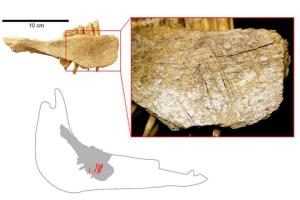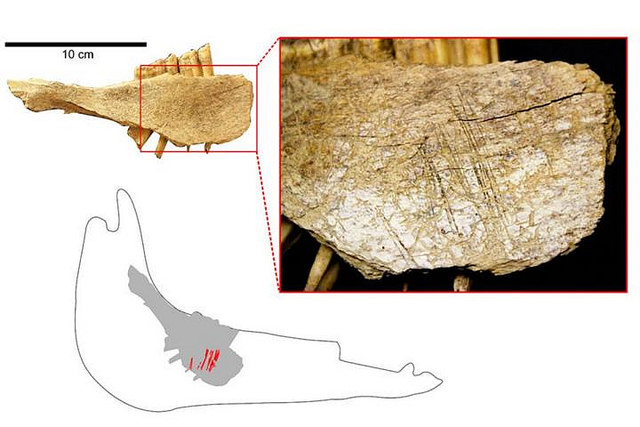
UNIVERSITY OF MONTREAL—The timing of the first entry of humans into North America across the Bering Strait has now been set back 10,000 years.
This has been demonstrated beyond a shadow of a doubt by Ariane Burke, a professor in Université de Montréal’s Department of Anthropology, and her doctoral student Lauriane Bourgeon, with the contribution of Dr. Thomas Higham, Deputy Director of Oxford University’s Radiocarbon Accelerator Unit.
Their findings were published in early January in the open-access journal PLoS One.
The earliest settlement date of North America, until now estimated at 14,000 years Before Present (BP) according to the earliest dated archaeological sites, is now estimated at 24,000 BP, at the height of the last ice age or Last Glacial Maximum.
The researchers made their discovery using artifacts from the Bluefish Caves, located on the banks of the Bluefish River in northern Yukon near the Alaska border. The site was excavated by archaeologist Jacques Cinq-Mars between 1977 and 1987. Based on radiocarbon dating of animal bones, the researcher made the bold hypothesis that human settlement in the region dated as far back as 30,000 BP.
In the absence of other sites of similar age, Cinq-Mars’ hypothesis remained highly controversial in the scientific community. Moreover, there was no evidence that the presence of horse, mammoth, bison and caribou bones in the Bluefish Caves was due to human activity.
To set the record straight, Bourgeon examined the approximate 36,000 bone fragments culled from the site and preserved at the Canadian Museum of History in Gatineau—an enormous undertaking that took her two years to complete. Comprehensive analysis of certain pieces at UdeM’s Ecomorphology and Paleoanthropology Laboratory revealed undeniable traces of human activity in 15 bones. Around 20 other fragments also showed probable traces of the same type of activity.
“Series of straight, V-shaped lines on the surface of the bones were made by stone tools used to skin animals,” said Burke. “These are indisputable cut-marks created by humans.”
Bourgeon submitted the bones to further radiocarbon dating. The oldest fragment, a horse mandible showing the marks of a stone tool apparently used to remove the tongue, was radiocarbon-dated at 19,650 years, which is equivalent to between 23,000 and 24,000 cal BP (calibrated years Before Present).
______________________________________
This horse mandible from Cave 2 shows a number of cut marks on the lingual surface. They show the animal’s tongue was cut out with a stone tool. Credit: Université de Montréal
____________________________________________________
“Our discovery confirms previous analyses and demonstrates that this is the earliest known site of human settlement in Canada,” said Burke. It shows that Eastern Beringia was inhabited during the last ice age.”
Beringia is a vast region stretching from the Mackenzie River in the Northwest Territories to the Lena River in Russia. According to Burke, studies in population genetics have shown that a group of a few thousand individuals lived in isolation from the rest of the world in Beringia 15,000 to 24,000 years ago.
“Our discovery confirms the ‘Beringian standstill [or genetic isolation] hypothesis,'” she said, “Genetic isolation would have corresponded to geographical isolation. During the Last Glacial Maximum, Beringia was isolated from the rest of North America by glaciers and steppes too inhospitable for human occupation to the West. It was potentially a place of refuge.”
The Beringians of Bluefish Caves were therefore among the ancestors of people who, at the end of the last ice age, colonized the entire continent along the coast to South America.
The results of Lauriane Bourgeon’s doctoral research were published in the January 6 edition of PLoS One under the title “Earliest Human Presence in North America Dated to the Last Glacial Maximum: New Radiocarbon Dates from Bluefish Caves, Canada.” The article is co-authored by Professor Burke and by Dr. Thomas Higham of Oxford University’s Radiocarbon Accelerator Unit, in the U.K.
Article Source: University of Montreal news release
___________________________________________________
Subscribe to Popular Archaeology Premium. Available on all laptops and mobile devices, and still the industry’s best value at only $9.00 annually.
___________________________________________
Travel and learn with Far Horizons.
____________________________________________
This richly illustrated issue includes the following stories: Recent findings shedding new light on the whereabouts of the remains of Philip of Macedon, father of Alexander the Great; how an archaeologist-sculptor is bringing bones of the dead back to life; archaeologists uncovering town life at the dawn of civilization; an exclusive interview with internationally acclaimed archaeologist James M. Adovasio about what makes the Meadowcroft Rockshelter prominent in the ongoing search for the first Americans; what archaeologists are finding at the site of the ancient city of Gath, the home town of the biblical Philistine giant, Goliath; and how scientists are redrawing the picture of human evolution in Europe. Find it on Amazon.com.






